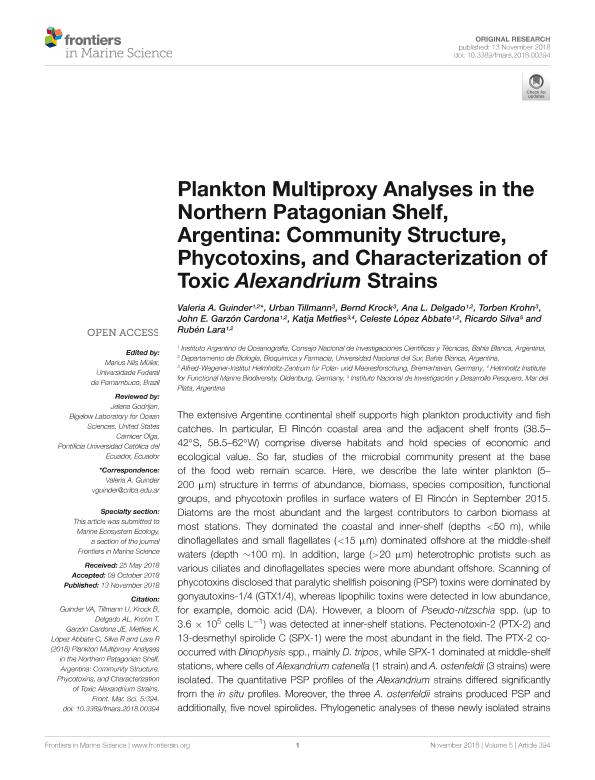Mostrar el registro sencillo del ítem
dc.contributor.author
Guinder, Valeria Ana

dc.contributor.author
Tillmann, Urban
dc.contributor.author
Krock, Bernd

dc.contributor.author
Delgado, Ana Laura

dc.contributor.author
Krohn, Torben
dc.contributor.author
Garzon Cardona, John Edison

dc.contributor.author
Metfies, Katja
dc.contributor.author
López Abbate, María Celeste

dc.contributor.author
Silva, Ricardo
dc.contributor.author
Lara, Ruben Jose

dc.date.available
2019-11-13T00:24:19Z
dc.date.issued
2018-11
dc.identifier.citation
Guinder, Valeria Ana; Tillmann, Urban; Krock, Bernd; Delgado, Ana Laura; Krohn, Torben; et al.; Plankton Multiproxy Analyses in the Northern Patagonian Shelf, Argentina: Community Structure, Phycotoxins, and Characterization of Toxic Alexandrium Strains; Frontiers Media SA; Frontiers In Marine Science; 5; NOV; 11-2018; 1-21
dc.identifier.issn
2296-7745
dc.identifier.uri
http://hdl.handle.net/11336/88708
dc.description.abstract
The extensive Argentine continental shelf supports high plankton productivity and fish catches. In particular, El Rincón coastal area and the adjacent shelf fronts (38.5-42°S, 58.5-62°W) comprise diverse habitats and hold species of economic and ecological value. So far, studies of the microbial community present at the base of the food web remain scarce. Here, we describe the late winter plankton (5-200 μm) structure in terms of abundance, biomass, species composition, functional groups, and phycotoxin profiles in surface waters of El Rincón in September 2015. Diatoms are the most abundant and the largest contributors to carbon biomass at most stations. They dominated the coastal and inner-shelf (depths < 50 m), while dinoflagellates and small flagellates ( < 15 μm) dominated offshore at the middle-shelf waters (depth ~100 m). In addition, large ( > 20 μm) heterotrophic protists such as various ciliates and dinoflagellates species were more abundant offshore. Scanning of phycotoxins disclosed that paralytic shellfish poisoning (PSP) toxins were dominated by gonyautoxins-1/4 (GTX1/4), whereas lipophilic toxins were detected in low abundance, for example, domoic acid (DA). However, a bloom of Pseudo-nitzschia spp. (up to 3.6 × 105 cells L-1) was detected at inner-shelf stations. Pectenotoxin-2 (PTX-2) and 13-desmethyl spirolide C (SPX-1) were the most abundant in the field. The PTX-2 co-occurred with Dinophysis spp., mainly D. tripos, while SPX-1 dominated at middle-shelf stations, where cells of Alexandrium catenella (1 strain) and A. ostenfeldii (3 strains) were isolated. The quantitative PSP profiles of the Alexandrium strains differed significantly from the in situ profiles. Moreover, the three A. ostenfeldii strains produced PSP and additionally, five novel spirolides. Phylogenetic analyses of these newly isolated strains from the South Atlantic revealed a new ribotype group, suggesting a biogeographical distinction in the population. The plankton survey presented here contributes baseline knowledge to evaluate potential ecosystem changes and track the global distribution of toxigenic species.
dc.format
application/pdf
dc.language.iso
eng
dc.publisher
Frontiers Media SA

dc.rights
info:eu-repo/semantics/openAccess
dc.rights.uri
https://creativecommons.org/licenses/by/2.5/ar/
dc.subject
ALEXANDRIUM OSTENFELDII
dc.subject
FUNCTIONAL GROUPS
dc.subject
NOVEL SPIROLIDES
dc.subject
PATAGONIAN SHELF
dc.subject
PHYCOTOXINS
dc.subject
PROTISTS' PLANKTON
dc.subject
SHELF FRONT
dc.subject
SW ATLANTIC
dc.subject.classification
Oceanografía, Hidrología, Recursos Hídricos

dc.subject.classification
Ciencias de la Tierra y relacionadas con el Medio Ambiente

dc.subject.classification
CIENCIAS NATURALES Y EXACTAS

dc.title
Plankton Multiproxy Analyses in the Northern Patagonian Shelf, Argentina: Community Structure, Phycotoxins, and Characterization of Toxic Alexandrium Strains
dc.type
info:eu-repo/semantics/article
dc.type
info:ar-repo/semantics/artículo
dc.type
info:eu-repo/semantics/publishedVersion
dc.date.updated
2019-09-10T20:24:52Z
dc.journal.volume
5
dc.journal.number
NOV
dc.journal.pagination
1-21
dc.journal.pais
Suiza

dc.journal.ciudad
Lausanne
dc.description.fil
Fil: Guinder, Valeria Ana. Consejo Nacional de Investigaciones Científicas y Técnicas. Centro Científico Tecnológico Conicet - Bahía Blanca. Instituto Argentino de Oceanografía. Universidad Nacional del Sur. Instituto Argentino de Oceanografía; Argentina. Universidad Nacional del Sur. Departamento de Biología, Bioquímica y Farmacia; Argentina
dc.description.fil
Fil: Tillmann, Urban. Alfred-Wegener-Institut Helmholtz-Zentrum für Polar- und Meeresforschung; Alemania
dc.description.fil
Fil: Krock, Bernd. Alfred-Wegener-Institut Helmholtz-Zentrum für Polar- und Meeresforschung; Alemania
dc.description.fil
Fil: Delgado, Ana Laura. Consejo Nacional de Investigaciones Científicas y Técnicas. Centro Científico Tecnológico Conicet - Bahía Blanca. Instituto Argentino de Oceanografía. Universidad Nacional del Sur. Instituto Argentino de Oceanografía; Argentina. Universidad Nacional del Sur. Departamento de Biología, Bioquímica y Farmacia; Argentina
dc.description.fil
Fil: Krohn, Torben. Alfred-Wegener-Institut Helmholtz-Zentrum für Polar- und Meeresforschung; Alemania
dc.description.fil
Fil: Garzon Cardona, John Edison. Consejo Nacional de Investigaciones Científicas y Técnicas. Centro Científico Tecnológico Conicet - Bahía Blanca. Instituto Argentino de Oceanografía. Universidad Nacional del Sur. Instituto Argentino de Oceanografía; Argentina. Universidad Nacional del Sur. Departamento de Biología, Bioquímica y Farmacia; Argentina
dc.description.fil
Fil: Metfies, Katja. Alfred-Wegener-Institut Helmholtz-Zentrum für Polar- und Meeresforschung; Alemania. Helmholtz Institute for Functional Marine Biodiversity; Alemania
dc.description.fil
Fil: López Abbate, María Celeste. Consejo Nacional de Investigaciones Científicas y Técnicas. Centro Científico Tecnológico Conicet - Bahía Blanca. Instituto Argentino de Oceanografía. Universidad Nacional del Sur. Instituto Argentino de Oceanografía; Argentina. Universidad Nacional del Sur. Departamento de Biología, Bioquímica y Farmacia; Argentina
dc.description.fil
Fil: Silva, Ricardo. Instituto Nacional de Investigación y Desarrollo Pesquero; Argentina
dc.description.fil
Fil: Lara, Ruben Jose. Consejo Nacional de Investigaciones Científicas y Técnicas. Centro Científico Tecnológico Conicet - Bahía Blanca. Instituto Argentino de Oceanografía. Universidad Nacional del Sur. Instituto Argentino de Oceanografía; Argentina. Universidad Nacional del Sur. Departamento de Biología, Bioquímica y Farmacia; Argentina
dc.journal.title
Frontiers In Marine Science

dc.relation.alternativeid
info:eu-repo/semantics/altIdentifier/url/https://www.frontiersin.org/article/10.3389/fmars.2018.00394/full
dc.relation.alternativeid
info:eu-repo/semantics/altIdentifier/doi/http://dx.doi.org/10.3389/fmars.2018.00394
Archivos asociados
